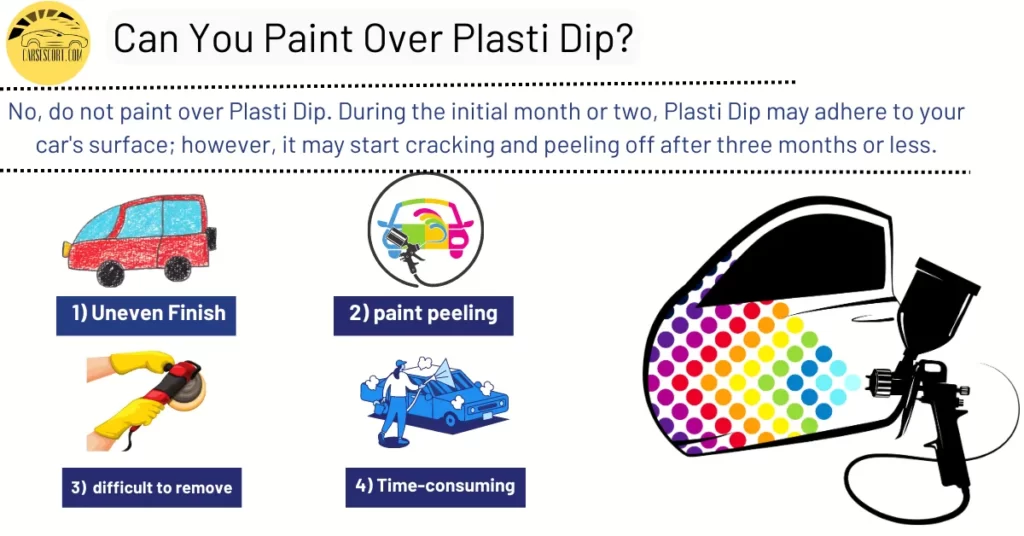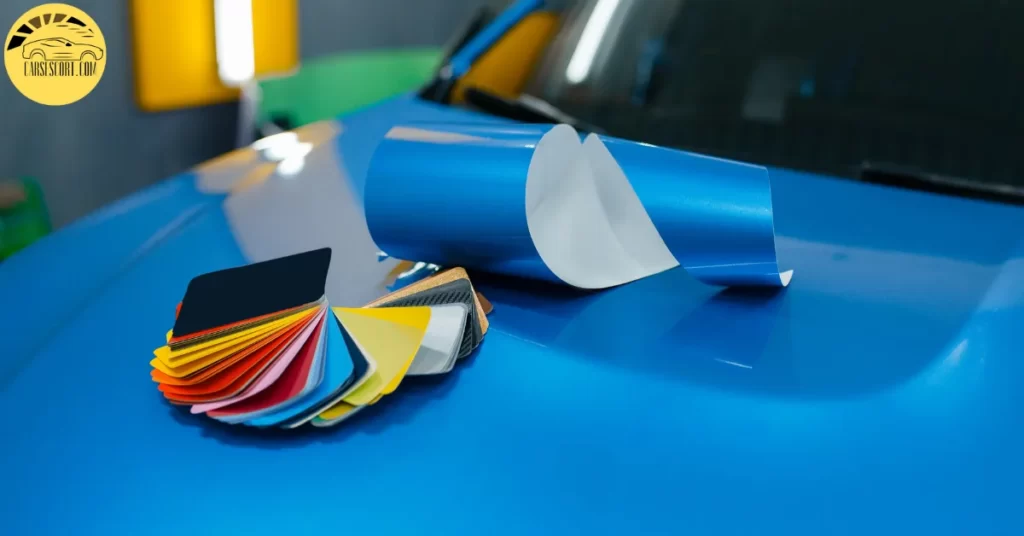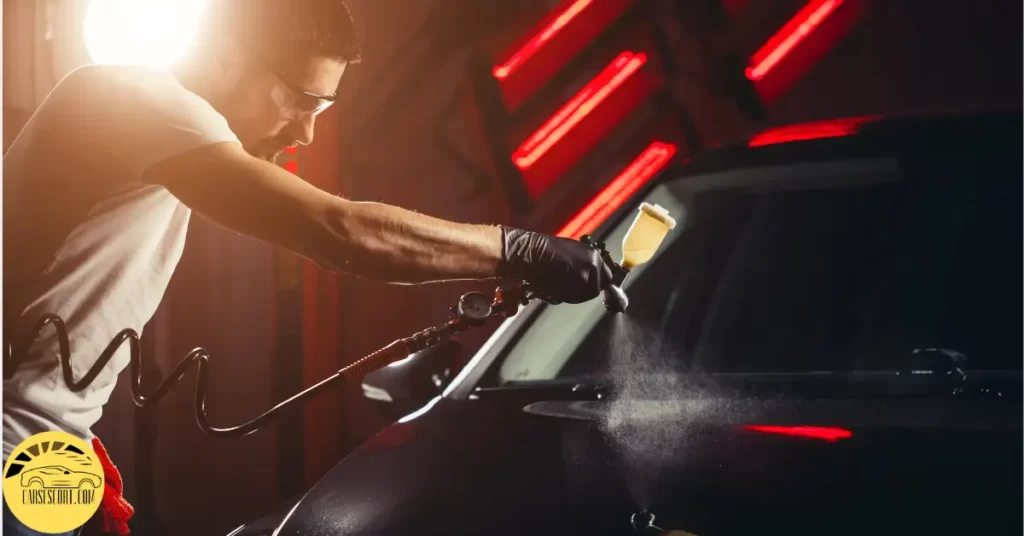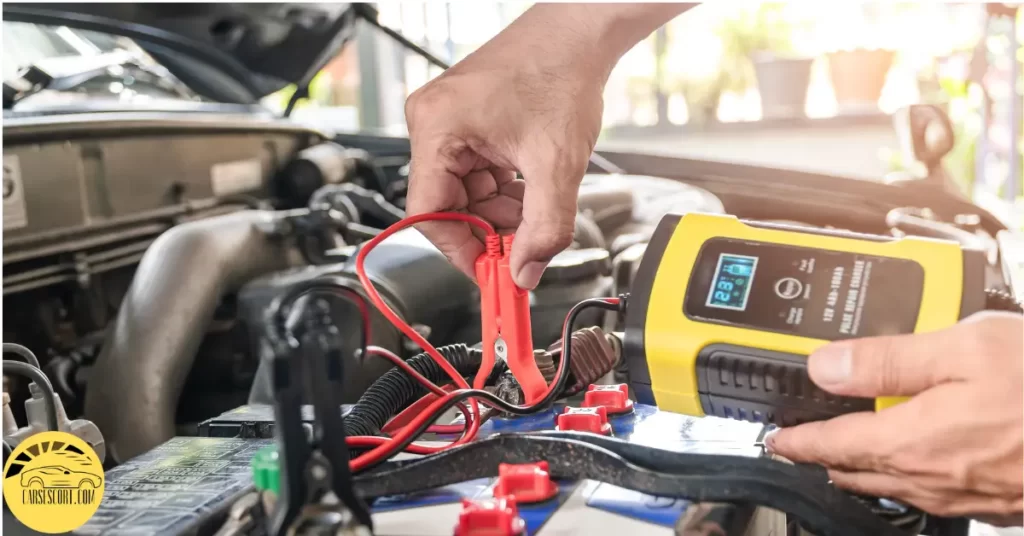Plasti Dip also known as Car and Rim Dipping is a popular rubberized vehicle coating solution that protects and modifies various surfaces. It is commonly used to coat cars, rims, and other items to give them a unique look and protect them from the elements. However, you may want to change the texture, color, and style of your Plasti Dip coating. In such cases, the question arises: can you paint over Plasti Dip?
- No, do not paint over Plasti Dip.
- During the initial month or two, Plasti Dip may adhere to your car’s surface; however, it may start cracking and peeling off after three months or less.
- It’s recommended to test on a small area first. After applying, give it ample time to settle and observe how well it adheres to the protective coating.
- This approach can help you gauge the effectiveness of Dip coating and make informed decisions about using it on a larger scale.
What Is Plasti Dip Coating?
Plasti Dip is a coating commonly used to give a protective layer to a car’s paint job. It is a liquid rubber that can be sprayed on or brushed onto a vehicle exterior and rims and then dried into a flexible, rubbery coating.
Car and rim dipping can protect the cars first coat from scratches, UV damage, and other types of wear and tear. It also comes in various colors, making it a popular choice for customizing the appearance of vehicles.
Can You Paint Over Plasti Dip?
The short answer is no, you should not paint over Plasti Dip.
Pint over plasti dip may initially adhere well to your car’s surface; however, Over time, it can begin to crack and peel off.
If you attempt to paint over rubber Dip, the new paint color may not adhere properly, resulting in an uneven finish that will not last.
It is always recommended first to test the color paint on a small area to observe how well it adheres to the the car protective layer. This can help you gauge the effectiveness of the Dip coating and make informed decisions about using it on a larger scale.
If you have already applied car and rim dipping to your car and are unhappy with the results, removing it before attempting to paint over it is the best course of action.
There are several methods for removing, including peeling it off by hand, using a pressure washer, or using a specialized dip dissolver product.

Cons of Paint Over Plasti Dip
- Painting over Plasti Dip may result in an uneven finish that will not last for extended period.
- Paint may not adhere well to new paint resulting in the new paint peeling off along with the coating.
- You may end up with a thick layer of paint that can be difficult to remove in the future.
- This may result in a less durable finish than if you had painted directly onto the car’s exterior.
- If the Plasti Dip is not appropriately removed before painting, it can affect the adhesion of the new paint and result in a poor-quality finish.
- It can be time-consuming and costly, especially if the result is unsatisfactory.
Does Paint Hold Onto Plasti Dip?
While it is possible to apply paint over Plasti Dip, it’s important to note that the success of adhesion may vary depending on several factors.
Initially, Plastic Dip can hold the paint well, but as time passes, the paint may start to peel and scrape off the surface of the dip.
Will Paint Make It Hard For You To Peel Plasti Dip On A Car?
Yes, paint could make peeling Plasti Dip off a car more difficult. Plasti Dip can be peeled off when it is no longer needed. However, if the paint has been applied over the protective coating, Some thin layer of pint could adhere to the coat and make it harder to peel off.

How Do I Remove Painted Plasti Dip?
To remove painted Plasti Dip, you can follow these steps:
1) Prepare the necessary materials
A pressure washer, a plastic scraper or credit card, a microfiber towel, rubbing alcohol, and mild detergent.
2) Start with a pressure washer
Use a pressure washer to remove as much of the painted Plasti Dip as possible. The pressure washer will help loosen the coating from the cars body.
3) Use a scraper or credit card
After using a pressure washer, use a plastic scraper or credit card to scrape off any remaining dipping coat. Be careful not to scratch the surface of the object.
4) Apply rubbing alcohol
Apply rubbing alcohol to the surface of the object to help dissolve any remaining rubberized coating . Let the alcohol sit on the car’s exterir for a few minutes.
5) Use a microfiber towel
Use a microfiber towel to wipe away any remaining Dip. If necessary, repeat the rubbing alcohol and wiping process until the coat has been removed.
6) Clean the surface
Once the rubber coat has been removed, clean the vehicle’s surface with mild detergent and water to remove any residue.
Note: It’s essential to take caution when using a pressure washer or scraping tool, as they may cause damage to the object if not used properly.
You May Also Like To Read:
How To Use Paint Over Plasti Dip?
It is important to ensure your vehicle is clean and free of dirt or debris. Wash your car with soap and water and then dry it thoroughly.
It is recommended to use a primer specifically designed for use with Plasti Dip to improve the adhesion of the paint to the surface.
It is essential to use paint compatible with Plasti Dip. Acrylic paints are generally recommended, as they are flexible and will not crack or peel over time.
Can You Spray Paint Over Plasti Dip?
No, it is not recommended to spray paint over Plasti Dip.
Spray painting over Plasti Dip may not result in a smooth and even finish, as the Plasti Dip layer may interfere with the adhesion of the paint.
The paint may not be able to fully bond to the rubberized coating, leading to cracking or peeling of the paint layer.

When Should You Avoid Using Spray Paint On Plasti Dip?
Avoid spray paint on Plasti Dip if the coating is still wet or has not fully cured. Attempting to spray paint over wet or uncured Plasti Dip can cause the protective coating bubble or peel, ruining the finish.
It is recommended to wait until the Plastic coat is fully cured before applying other coatings.
If the body being coated is irregular or has deep ridges or crevices. Plasti Dip is designed to conform to the surface it is applied to, creating a smooth and even finish.
Spray paint over a deep ridge, or crevices may result in the paint not adhering properly, leading to uneven and unsightly results.
Instead Of Painting Over Plasti Dip, What Else Can I Do?
If you don’t want to paint over Plasti Dip, there are a few other alternative options you can consider:
- Remove it: You can remove the Plasti Dip using a dip dissolver or peeling it off. This will give you a clean surface to work with and allow you to apply a different type of coating.
- Vinyl wrap: You can apply a vinyl wrap instead of painting. Vinyl wraps come in various colors and finishes and can be easily applied with patience and practice.
- Powder coating: Powder coating is more durable and long-lasting than Plasti Dip. You can have your exterior powder coated in various colors and finishes.
- Hydro dipping: Hydro dipping, also known as water transfer printing, is a process where a film with a desired pattern is placed on the water’s surface, and then the object is dipped into the water. The film adheres to the object’s surface, giving it a unique and customized look.
- Ceramic coating: Ceramic coating is a highly durable and long-lasting coating that provides superior protection. It can be applied to various surfaces and comes in various colors and finishes.
FAQ
Can You Use 2k Clear Coat Over Plasti Dip?
Yes, you can use 2k clear coat over Plasti Dip. Plasti Dip is a flexible, rubberized coating that provides a protective layer for your car. 2k clear coat is a high-quality, durable coating that can protect the protective coating from scratches, fading, and other types of damage.
When applying a 2k clear coat over Plasti Dip, follow the manufacturer’s instructions and ensure that the Plasti Dip is completely dry before applying the clear coat.
Does Paint Plasti Dip Look Great?
It depends on individual choice. Plasti Dip can be painted with various colors and finishes, such as matte, gloss, metallic, and more. However, it’s essential to prepare the surface of the Plasti Dip before painting to ensure that the paint adheres properly.
Do you have to sand Plasti Dip before spray painting it?
Yes, it’s recommended to sand Plasti Dip lightly before spray painting it to ensure that the paint adheres properly. Sanding the car and rim dipping creates a rougher surface for the paint to grip onto, improving the adhesion of the paint.
Can I use acrylic paint over Plasti Dip?
It is recommended not to use any paint on the plastic dip, including acrylic.
However, if you use acrylic paint on the dip, it’s important to prepare the coat properly by lightly cleaning and sanding the Plasti Dip.
Can I Use Rustoleum Over Plasti Dip?
It is not recommended to use Rustoleum Over Plasti Dip application. This is because Rustoleum is a paint product not designed to be applied over Plasti Dip. Plasti Dip is a rubberized coating often used to protect and enhance the appearance of various surfaces. Applying Rustoleum over Plasti Dip may not adhere properly, and the finish may not look smooth and even.
My Final Thoughts
Can you paint over Plasti Dip? While some people may attempt to do so, personally I do not recommend. Although the paint may adhere initially, it will likely start peeling and flaking off after just a month or two.
However, if you do plan to paint, it’s best to test on a small area first and give it sufficient time to settle to see how well it adheres to the protective coating.
If you have any experience painting over Plasti Dip, please feel free to share your thoughts and experiences in the comments section.
Thank you!
Affiliate Disclosure: Cars Escort is a participant in the Amazon Services LLC Associates Program. As an Amazon Associate, we earn from qualifying purchases made through affiliate links on our site. Read Our Disclaimer .

